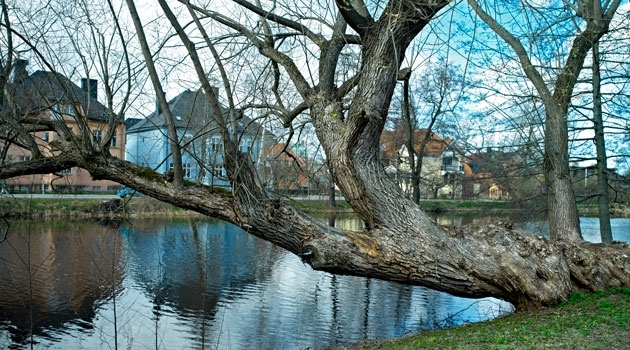Urban densification can have both positive and negative health effects
Urban green spaces and urban densification are both associated with a lower rate of mortality from cardiovascular disease. These apparently confounding results were published in a new article in the Journal of Epidemiology.
The study was conducted by Terry Hartig, professor in environmental psychology at IBF (Institute for Housing and Urban Research at Uppsala University), in collaboration with Zara Bergsten and Jan Amcoff, human geographers at IBF, and environmental epidemiologists in Scotland and Australia.
Photo: Mikael Wallerstedt
The research team found that existing research on urban green spaces and health often has been motivated by concerns about disappearing green spaces in the wake of urbanisation and densification. However, previous research has not studied whether the relationship between green spaces and health changes when population density increases, remains constant, or decreases.
“It is important to question and examine the idea that urban green spaces are an antidote to densification. Research on the benefits of green spaces needs to be joined with research on how urbanisation itself can be beneficial to health,” says Terry Hartig.
In the current article, the researchers have studied the mortality rates associated with cardiovascular disease in 1,432 Swedish parishes during the years 2000–2008.
Both urbanisation and green spaces can be beneficial to health
The researchers found that the parishes which have a relatively stable population density and greater access to greens spaces tended to have a lower rate of mortality from cardiovascular disease in the population. At the beginning of the period studied, these parishes already had a relatively large number of inhabitants and a greater population density. Among the more sparsely populated parishes, which experienced substantial population growth during the period, the researchers found a correlation between increased population density and a lower mortality rate.
“Urbanisation can have positive health benefits in smaller, more rural areas. In larger cities, however, it is important to conserve existing green spaces. Further densification in already densely built areas can undermine the public health benefits of urban green spaces, both through loss of land and a resulting reduction in quality of the remaining green spaces as they are shared by an increased number of people. On the other hand, densification in more sparsely populated areas can lead to other benefits, which may compensate for the loss of green spaces. For example, residents may gain better access to health care and other services which benefit health and well-being,” explains Terry Hartig.
The authors conclude that their results highlight the value of both the urban built environment and urban green spaces, as well as the relationship between them. The researchers hope that the study will encourage more research into how the positive aspects of densification can be weighed against the costs associated with the loss of urban green spaces.
Camilla Scheinert/Ulrika Wahlberg
Publication
Terry Hartig et. al. (2020) Associations between greenspace and mortality vary across contexts of community change: a longitudinal ecological study, Journal of Epidemiology and Community Health, 74, 534–540. doi:10.1136/jech-2019-213443
(Artikeln är publicerad “open access” och fritt tillgänglig.)

